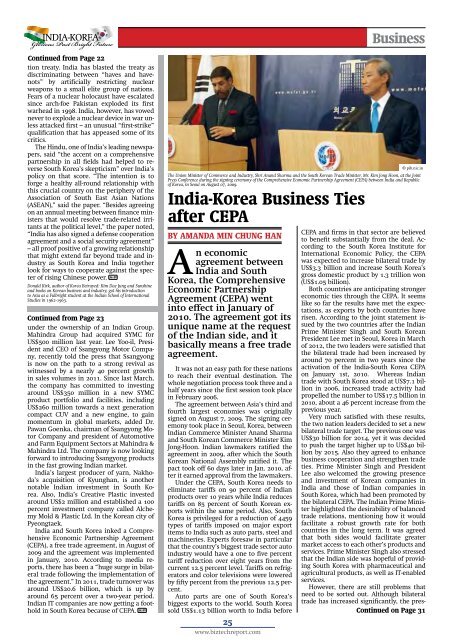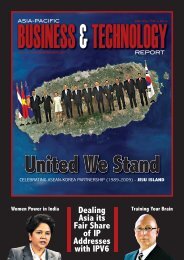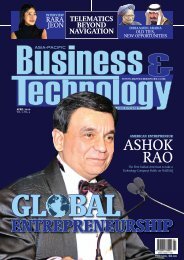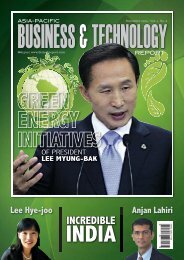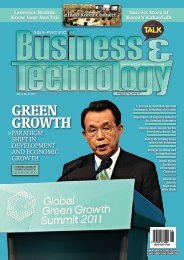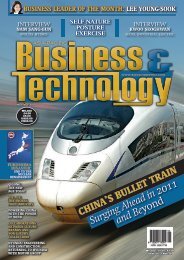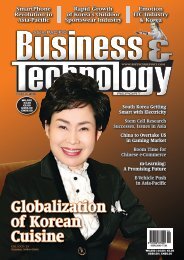INDIA-KOREA - Asia-Pacific Business and Technology Report
INDIA-KOREA - Asia-Pacific Business and Technology Report
INDIA-KOREA - Asia-Pacific Business and Technology Report
You also want an ePaper? Increase the reach of your titles
YUMPU automatically turns print PDFs into web optimized ePapers that Google loves.
<strong>INDIA</strong>-<strong>KOREA</strong><br />
Glorious Past Bright Future<br />
Continued from Page 22<br />
tion treaty. India has blasted the treaty as<br />
discriminating between “haves <strong>and</strong> havenots”<br />
by artificially restricting nuclear<br />
weapons to a small elite group of nations.<br />
Fears of a nuclear holocaust have escalated<br />
since arch-foe Pakistan exploded its first<br />
warhead in 1998. India, however, has vowed<br />
never to explode a nuclear device in war unless<br />
attacked first – an unusual “first-strike”<br />
qualification that has appeased some of its<br />
critics.<br />
The Hindu, one of India’s leading newspapers,<br />
said “the accent on a comprehensive<br />
partnership in all fields had helped to reverse<br />
South Korea’s skepticism” over India’s<br />
policy on that score. “The intention is to<br />
forge a healthy all-round relationship with<br />
this crucial country on the periphery of the<br />
Association of South East <strong>Asia</strong>n Nations<br />
(ASEAN),” said the paper. “Besides agreeing<br />
on an annual meeting between finance ministers<br />
that would resolve trade-related irritants<br />
at the political level,” the paper noted,<br />
“India has also signed a defense cooperation<br />
agreement <strong>and</strong> a social security agreement”<br />
– all proof positive of a growing relationship<br />
that might extend far beyond trade <strong>and</strong> industry<br />
as South Korea <strong>and</strong> India together<br />
look for ways to cooperate against the specter<br />
of rising Chinese power. A-P<br />
Donald Kirk, author of Korea Betrayed: Kim Dae Jung <strong>and</strong> Sunshine<br />
<strong>and</strong> books on Korean business <strong>and</strong> industry, got his introduction<br />
to <strong>Asia</strong> as a Fulbright student at the Indian School of International<br />
Studies in 1962-1963.<br />
CEPA <strong>and</strong> firms in that sector are believed<br />
to benefit substantially from the deal. According<br />
to the South Korea Institute for<br />
International Economic Policy, the CEPA<br />
was expected to increase bilateral trade by<br />
US$3.3 billion <strong>and</strong> increase South Korea’s<br />
gross domestic product by 1.3 trillion won<br />
(US$1.05 billion).<br />
Both countries are anticipating stronger<br />
economic ties through the CEPA. It seems<br />
like so far the results have met the expectations,<br />
as exports by both countries have<br />
risen. According to the joint statement issued<br />
by the two countries after the Indian<br />
Prime Minister Singh <strong>and</strong> South Korean<br />
President Lee met in Seoul, Korea in March<br />
of 2012, the two leaders were satisfied that<br />
the bilateral trade had been increased by<br />
around 70 percent in two years since the<br />
activation of the India-South Korea CEPA<br />
on January 1st, 2010. Whereas Indian<br />
trade with South Korea stood at US$7.1 billion<br />
in 2006, increased trade activity had<br />
propelled the number to US$17.5 billion in<br />
2010, about a 46 percent increase from the<br />
previous year.<br />
Very much satisfied with these results,<br />
the two nation leaders decided to set a new<br />
bilateral trade target. The previous one was<br />
US$30 billion for 2014, yet it was decided<br />
to push the target higher up to US$40 billion<br />
by 2015. Also they agreed to enhance<br />
business cooperation <strong>and</strong> strengthen trade<br />
ties. Prime Minister Singh <strong>and</strong> President<br />
Lee also welcomed the growing presence<br />
<strong>and</strong> investment of Korean companies in<br />
India <strong>and</strong> those of Indian companies in<br />
South Korea, which had been promoted by<br />
the bilateral CEPA. The Indian Prime Minister<br />
highlighted the desirability of balanced<br />
trade relations, mentioning how it would<br />
facilitate a robust growth rate for both<br />
countries in the long term. It was agreed<br />
that both sides would facilitate greater<br />
market access to each other’s products <strong>and</strong><br />
services. Prime Minister Singh also stressed<br />
that the Indian side was hopeful of providing<br />
South Korea with pharmaceutical <strong>and</strong><br />
agricultural products, as well as IT-enabled<br />
services.<br />
However, there are still problems that<br />
need to be sorted out. Although bilateral<br />
trade has increased significantly, the pres-<br />
Continued on Page 31<br />
Continued from Page 23<br />
under the ownership of an Indian Group.<br />
Mahindra Group had acquired SYMC for<br />
US$500 million last year. Lee Yoo-il, President<br />
<strong>and</strong> CEO of Ssangyong Motor Company,<br />
recently told the press that Ssangyong<br />
is now on the path to a strong revival as<br />
witnessed by a nearly 40 percent growth<br />
in sales volumes in 2011. Since last March,<br />
the company has committed to investing<br />
around US$350 million in a new SYMC<br />
product portfolio <strong>and</strong> facilities, including<br />
US$260 million towards a next generation<br />
compact CUV <strong>and</strong> a new engine, to gain<br />
momentum in global markets, added Dr.<br />
Pawan Goenka, chairman of Ssangyong Motor<br />
Company <strong>and</strong> president of Automotive<br />
<strong>and</strong> Farm Equipment Sectors at Mahindra &<br />
Mahindra Ltd. The company is now looking<br />
forward to introducing Ssangyong products<br />
in the fast growing Indian market.<br />
India’s largest producer of yarn, Nakhoda’s<br />
acquisition of Kyunghan, is another<br />
notable Indian investment in South Korea.<br />
Also, India’s Creative Plastic invested<br />
around US$2 million <strong>and</strong> established a 100<br />
percent investment company called Alchemy<br />
Mold & Plastic Ltd. In the Korean city of<br />
Pyeongtaek.<br />
India <strong>and</strong> South Korea inked a Comprehensive<br />
Economic Partnership Agreement<br />
(CEPA), a free trade agreement, in August of<br />
2009 <strong>and</strong> the agreement was implemented<br />
in January, 2010. According to media reports,<br />
there has been a “huge surge in bilateral<br />
trade following the implementation of<br />
the agreement.” In 2011, trade turnover was<br />
around US$20.6 billion, which is up by<br />
around 65 percent over a two-year period.<br />
Indian IT companies are now getting a foothold<br />
in South Korea because of CEPA. A-P<br />
India-Korea <strong>Business</strong> Ties<br />
after CEPA<br />
by Am<strong>and</strong>a Min Chung Han<br />
An economic<br />
agreement between<br />
India <strong>and</strong> South<br />
Korea, the Comprehensive<br />
Economic Partnership<br />
Agreement (CEPA) went<br />
into effect in January of<br />
2010. The agreement got its<br />
unique name at the request<br />
of the Indian side, <strong>and</strong> it<br />
basically means a free trade<br />
agreement.<br />
It was not an easy path for these nations<br />
to reach their eventual destination. The<br />
whole negotiation process took three <strong>and</strong> a<br />
half years since the first session took place<br />
in February 2006.<br />
The agreement between <strong>Asia</strong>’s third <strong>and</strong><br />
fourth largest economies was originally<br />
signed on August 7, 2009. The signing ceremony<br />
took place in Seoul, Korea, between<br />
Indian Commerce Minister An<strong>and</strong> Sharma<br />
<strong>and</strong> South Korean Commerce Minister Kim<br />
Jong-Hoon. Indian lawmakers ratified the<br />
agreement in 2009, after which the South<br />
Korean National Assembly ratified it. The<br />
pact took off 60 days later in Jan. 2010, after<br />
it earned approval from the lawmakers.<br />
Under the CEPA, South Korea needs to<br />
eliminate tariffs on 90 percent of Indian<br />
products over 10 years while India reduces<br />
tariffs on 85 percent of South Korean exports<br />
within the same period. Also, South<br />
Korea is privileged for a reduction of 4459<br />
types of tariffs imposed on major export<br />
items to India such as auto parts, steel <strong>and</strong><br />
machineries. Experts foresaw in particular<br />
that the country’s biggest trade sector auto<br />
industry would have a one to five percent<br />
tariff reduction over eight years from the<br />
current 12.5 percent level. Tariffs on refrigerators<br />
<strong>and</strong> color televisions were lowered<br />
by fifty percent from the previous 12.5 percent.<br />
Auto parts are one of South Korea’s<br />
biggest exports to the world. South Korea<br />
sold US$1.13 billion worth to India before<br />
25<br />
www.biztechreport.com<br />
<strong>Business</strong><br />
© pib.nic.in<br />
The Union Minister of Commerce <strong>and</strong> Industry, Shri An<strong>and</strong> Sharma <strong>and</strong> the South Korean Trade Minister, Mr. Kim Jong Hoon, at the Joint<br />
Press Conference during the signing ceremony of the Comprehensive Economic Partnership Agreement (CEPA) between India <strong>and</strong> Republic<br />
of Korea, in Seoul on August 07, 2009.


